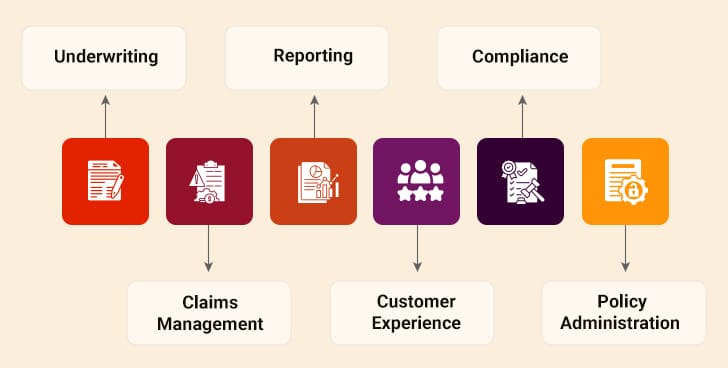With the fast-changing, dynamic business environment, it’s imperative for small and medium-sized insurance companies to accelerate their digital-first transformation journey to outperform competition and gain market share. Customers today need immediate responses; they demand digital experiences anytime, anywhere. When an insurer fails to meet the desired experience, unsatisfied customers knock on the competitor’s door offering better customer-facing applications.
While building new innovative, user and business-friendly applications has been the priority in recent years, insurance companies are now realizing the need to cut short the development time to reduce the time-to-market for their new products and services and have an edge over the insurance technology curve. But, amid overwhelming IT workloads and a global tech talent shortage, how can insurers achieve shorter development times for their applications? This is where the low-code application development platforms come to the rescue.
With an easy-to-use interface and a large library of ready-made, reusable components, low-code platforms enable small and medium-sized insurers to build apps faster than ever. The modularity of low-code expedites project timelines and alleviates the burden of monitoring every stage of the development cycle, allowing businesses to focus on their core competencies.
In this blog, we’ll look at the advantages of using low-code in insurance and why such platforms are an attractive investment option for small and medium-sized insurance businesses.
Table of Contents
The Need for Insurance Digital Transformation
Low-Code For Insurance: The Catalyst for Digital Transformation
Why Are Low-Code Digital Platforms So Popular Among Small and Medium-sized Insurers Today?
Business Cases for Leveraging Low-Code Platforms in the Insurance Industry
Key Challenges Insurers Must Navigate with Low-Code Platforms
Looking for the Right Low-Code Insurance Platforms? Here’s What You Need to Know First!
The Need for Insurance Digital Transformation
Digital transformation is not a new concept in the insurance industry, but many insurers still rely on legacy systems to manage their core processes and are slow in embracing the much-needed transformation wave compared to other industries. However, digitizing the laggard insurance sector has become the need of the hour to get an edge over the technology disruption threat. Moving toward digitization enables insurers to:
- Increase process efficiency through automation across claims management, policy administration, underwriting functions, customer onboarding, and more
- Replace manual processes with advanced analytics, artificial intelligence (AI), and machine learning (ML) algorithms to reduce manual errors
- Accelerate time-to-market by enabling faster development cycles and quicker ramp-up times for launching new products or services
- Lower operational costs by reducing the human effort required for repetitive tasks, such as data entry, reporting, document processing, and analytics
- Enhance customer experience with faster service delivery, personalized offerings, and lower cost-to-serve models
- Strengthen compliance and risk management by automating regulatory reporting and integrating real-time monitoring tools
Now that it is clear that insurance businesses are pushed to undertake digitization, let’s look at how low-code platforms feature against this requirement.
Low-Code For Insurance: The Catalyst for Digital Transformation
The extraordinarily disruptive -code approach is a software development method that enables the delivery of applications faster and with minimal hand-coding. Low-code platforms are a great way to speed up the digital transformation process. They enable developers to bypass extensive hand-coding, speeding up the process of getting an application to production. As a result, businesses can create seamless, intuitive, user experience-driven applications more quickly while ensuring security, interoperability, and flexibility.
Low-code in insurance helps insurers build a new distribution channel in no time. With limited resources, they can quickly launch mobile apps or websites, allowing customers to interact effortlessly with the insurance business—without needing to call or visit a physical office. This leads to enhanced customer experiences delivered in less time and at lower costs than traditional software development methods (SDLC).
With low-code solutions, insurance companies can keep up with the changing digital landscape and outcompete with innovation. With new technologies coming out almost every day, it can be difficult for traditional software development teams to stay on top of everything that is happening in the world of tech.
In the next section, we will take a more in-depth look at the role of low-code digital platform development in the insurance sector and how it differs from traditional development.
Traditional Development vs. Low-Code Development
| Aspect | Traditional Development | Low-Code Development |
| Development Speed | Slow – from several months to years | Fast – from few weeks to months |
| Cost | High as it requires large teams | Lower as it requires fewer resources |
| Customization | Highly customizable with full control | Moderate customization depending on platform capabilities |
| Integration | Complex as custom API development is needed | Easier with pre-built connectors and API integration tools |
| Ideal For | Large, complex, unique insurance systems | Standard processes, quick MVPs, modernization projects |
Why Are Low-Code Digital Platforms So Popular Among Small and Medium-sized Insurers Today?
The low-code technology market in insurance is projected to grow at a CAGR of 18.16% between 2024 and 2031. What’s driving this surge? Low-code application development platforms empower insurers to build applications ten times faster. They allow for application tweaks in a matter of a few hours instead of months. That’s a remarkable improvement and a significant solution for small and medium-sized insurance companies wanting an edge in the highly competitive market. They do not require massive upfront capital investment in setup, deployment, and training. Moreover, they are not very resource intensive to the extent of engaging full-fledged development teams, as would have been the case for custom software development.
The platforms are highly scalable and configurable to be tailored as per the insurer’s requirements. Since it has a drag-and-drop interface instead of a programming language, insurers can choose what features they want to use as per their business requirements. At the same time, they possess limited functionality, eliminating choice paralysis that may hamstring the software development process. Additionally, they are easy to use, which enhances their adoption.
Now that we’ve covered the value proposition and relevance of low-code development in insurance, it’s time to review how it impacts core business processes.
Business Cases for Leveraging Low-Code Platforms in the Insurance Industry
Low-code digital platforms are a great solution for insurance companies that have an opportunity to accelerate their business growth. In particular, low-code platforms can be used to help manage claims, underwriting, and custom-built agent portals more efficiently.
The following business cases illustrate how low-code platforms can be used in the insurance industry:

1. Underwriting
Underwriting, once a paperwork-heavy marathon, now finds itself transformed. Low-code platforms automate and make insurance underwriting processes such as rating, quoting, and policy issuance more efficient. This helps insurers reduce the manual effort required of underwriters while providing real-time visibility into customer data to adjust policies according to customer profiles and requirements. Such a personalized approach to underwriting will result in more satisfied and loyal customers.
2. Claims Management
Low-code solutions simplify and streamline the claims process by automating processes such as quotation generation, quoting approval, and payment submission – amongst other things. Such insurance claims management systems reduce the number of employees involved. As fewer people have access to sensitive information about customers’ histories or claims history, fraud prevention becomes easier than ever before. It can help you increase profitability margins and loss ratio over the long term and grow revenues over time.
3. Reporting
Low-code insurance platforms are also used to automate insurance reporting purposes based on processes like claim management, loss adjustment, fraud detection, and audit compliance. Reporting automation enables businesses to visualize opportunities, cut operating costs, and address bottlenecks.
4. Customer Experience
Low-code platforms enable insurers to build and deliver the omnichannel digital experience that the customers need. They also help insurers respond quickly to customer expectations for flexibility, speed, and ease of use. Their feature of building and testing in real-time allows insurers to reduce customer dissatisfaction which causes churn rapidly. The insurers can also quickly build chatbots and mobile apps to cross-sell and up-sell the products to the customers as per their requirements and any channel of choice and grow their revenue faster.
5. Compliance
In the ever-changing regulatory environment of the insurance industry, insurers are usually slow in adopting the changes and transforming their processes accordingly. Low-code for insurance can help small and medium-sized insurers customize their workflows, business logic and rules, and user interface in hours, instead of weeks and months to adhere to the regulatory demands faster. This enables the insurers to focus more on user needs and become truly customer-centric.
6. Policy Administration
Policy administration, often underestimated, also benefits enormously from low-code. Customers expect self-service options for tasks like endorsements, renewals, and policy information changes. Low-code insurance platforms empower insurers to roll out sleek, customer-facing portals without waiting a year for IT to catch up. Automation handles the heavy lifting behind the scenes while clean, intuitive interfaces delight users on the front end.
Unlock Innovation with Low-Code Insurance Solutions
Key Challenges Insurers Must Navigate with Low-Code Platforms
While low-code solutions insurance platforms open thrilling new avenues, they are not a silver bullet. Astute insurers understand that with great power comes significant responsibility — and a few hidden pitfalls along the way.
One major challenge is the risk of creating “spaghetti apps.” With business users across departments empowered to build applications independently, organizations may find themselves entangled in a messy web of poorly integrated systems. Operational chaos can quickly occur when each division develops its tools without alignment to a centralized roadmap. Establishing strong governance frameworks for low-code insurance adoption is necessary to maintain cohesion and strategic focus.
Customization also presents a notable hurdle. Although low-code platforms offer impressive modularity and flexibility, specific complex insurance processes may stretch beyond the standard out-of-the-box functionalities. Deep customizations often demand traditional coding expertise. Without careful planning, organizations may incur significant costs by requiring external technical consultants — a hidden expenditure that could disrupt carefully crafted budgets.
Security and compliance remain critical concerns. Given that the insurance sector manages highly sensitive, regulation-intensive data, not every low-code insurance platform will naturally meet the required industry standards. Insurers must rigorously verify that any platform under consideration provides advanced encryption, robust user authentication mechanisms, and comprehensive regulatory compliance features from the outset.
Talent management adds another layer of complexity. Low-code insurance platforms do not eliminate the need for skilled IT professionals; instead, they redefine IT roles. Teams must evolve from pure coders into enablers, solution architects, and vigilant security stewards. Ensuring that technical teams are prepared for this shift is essential to avoiding half-built applications and dangerous security gaps.
Finally, organizational culture must be addressed. Successful low-code insurance adoption demands a mindset geared toward agility, experimentation, and a tolerance for rapid iteration — concepts that may seem alien within traditionally conservative, risk-averse insurance firms. Without strong executive sponsorship and a structured change management strategy, even the most promising low-code initiatives risk stagnation.
Ultimately, low-code for insurance promises extraordinary benefits, but only for insurers equipped to steer through the inherent complexities with precision. With a judicious balance of freedom and control, small and medium-sized insurers can harness the full potential of low-code and scale new heights in the digital landscape.
Looking for the Right Low-Code Insurance Platforms? Here’s What You Need to Know First!
As emphasized earlier in the post, low-code in insurance offers immense business benefits. However, not all low-code platforms are built the same. Before starting the search, insurers must identify what they need from a low-code platform. List down the business requirements, organizational goals, and budget. These parameters will help define which platform is ideal for the company.
Insurers should ideally look for a low-code platform that allows them to fully customize the interface and seamlessly integrates with other existing systems to streamline operations. After all, these are seen as the primary limitations of low-code development. After addressing these, consider ease of use and the ability to expand as such traits promise long-term usability of the tool.
Conclusion
Low-code insurance platforms are a powerful tool for accelerating digital transformation in the insurance sector. They allow companies to take advantage of new-gen technologies without compromising the user experience or taking on unnecessary risks. Low-code platforms are also perfect for small and medium-sized businesses that might not have enough resources to get their custom software built from scratch. All in all, low-code for insurance is aimed at democratizing programming and reducing IT backlogs while empowering insurers to embrace modernization.
Case in Focus
A leading financial services provider partnered with us to address critical challenges from disparate legacy systems. We created a customized, cloud-based customer experience portal powered by InsuranceNXT. The intuitive portal significantly improved the customer experience and opened new avenues for upselling and cross-selling. To know more, refer to the complete case study.






